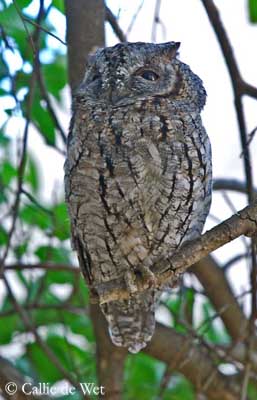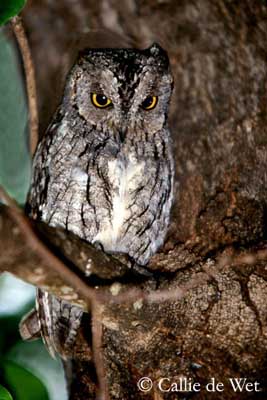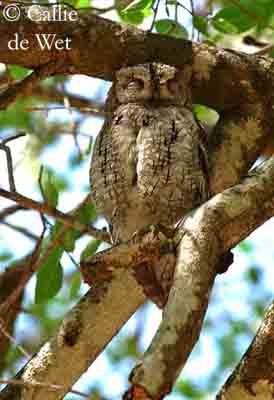
African Scops Owl
Otus senegalensis
Strigiforme Order – Strigidae Family
BIOMETRICS:
Length : 17-20 cm
Wingspan : 40645 cm
Weight : 45-120 gr
DESCRIPTION:
African Scops-Owl is a slender little « eared » owl with two forms, grey or rufous-grey all over. It is endemic to South Africa.
African Scops-Owl adult has grey plumage, overall shades of medium-grey with tawny streaking and fine grey black vermiculations, heaviest on head and breast. Scapulars have white tips. A rufous wash on upperwing coverts varies individually between grey and rufous morphs. Flight feathers are dark grey barred with white to pale buff. Tail is grey with indistinct dark bars.
Underparts are slightly lighter grey with dark streaks. Underwing coverts are buff with slight grey streaks.
Facial disk is grey and unstreaked, with dark rim. Bill is blackish. Eyes are yellow. Sparsely feathered legs and small bare feet are pale brown. It has prominent ear tufts, held erect at rest, but more flatten when hunting.
DIET:
African Scops-Owl feeds mainly on small animals such as cockroaches, mole crickets, mantises, lizards, worms, spiders, moths and larvae.
PROTECTION / THREATS / STATUS:
African Scops-Owl populations are not threatened at this time, and owls are widespread in some areas in suitable habitat in their range.
Ang: African Scops Owl
All : Afrika-Zwergohreule
Esp : Autillo Africano
Ital : Assiolo africano
Nd : Afrikaanse Dwergooruil
Russe : Совка африканская
Sd : Afrikansk dvärguv
Photographe:
Callie de Wet
GALLERY
Sources :
HANDBOOK OF THE BIRDS OF THE WORLD Vol 5 by Josep del Hoyo-Andrew Elliott-Jordi Sargatal - Lynx Edicions - ISBN: 8487334253
BIRDS OF AFRICA SOUTH OF THE SAHARA by Ian Sinclair and Peter Ryan - Princeton University Press Princeton and Oxford - ISBN: 0691118159
Owls and Owling in Southern Africa by Warwick Tarboton and Rudy Erasmus - Tracey Hawthorne - ISBN: 1868721043

Both sexes are similar in size and plumage.
An isolated population in Pagalu (Annobon Island) is darker and more heavily streaked.
Juvenile resembles adults, but it is slightly paler with brown tinge. Ear tufts are shorter.
Nestlings are covered with grey down.
VOICE: SOUNDS BY XENO-CANTO
African Scops-Owl utters series of low, hollow dove-like notes. We can also hear an isolated and brief “prrroop” on a single note. At night, its single monotonously repeated call-note “kruup” is the best manner to locate the bird.
HABITAT:
African Scops-Owl lives in well-wooded savannahs, sometimes in mangroves and gardens.
RANGE:
African Scops-Owl is widespread and resident in savannahs and woodlands of sub-Saharan Africa.
BEHAVIOUR:
African Scops-Owl is a nocturnal species. During the day, it roosts on a branch and stands upright, long and slender, with erect ear-tufts, and closing to slit its eyelids. It is very well camouflaged with its cryptic plumage when perched against the bark of a tree trunk.
It often returns on the same site each day for roosting, among tangled branches, or in the open against a vertical branch where it is very difficult to see it.
At night, head appears rounded, with ear-tufts tucked away.
It hunts primarily on small animals, diving from a low perch and pick up off the ground.

FLIGHT:
African Scops-Owl is rarely seen in flight. It flies short distances with fast wing beats, in an undulating manner.
REPRODUCTION:
African Scops-Owl nests in tree cavities, in natural holes, cavities in fence poles and buildings, and nest-boxes. They often use holes 200 to 500 mm deep, with vertical entrance.
Female lays 4 to 6 eggs from April to June, towards the end of rains, when food resources become abundant with insect outbreak.
Incubation lasts about 25 to 27 days, by female, while male remains invisible concealed some distance away. Male feeds female during this period.
Young are fed by both adults, with a high feeding tempo, about 66 times in seven hours at night. Young fledge at about one month of age.
